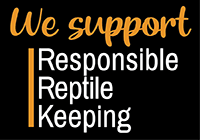Here’s Why You SHOULDN’T Be Using a Heat Mat for Your Reptile

Here’s Why You SHOULDN’T Be Using a Heat Mat for Your Reptile
Heat mats are an incredibly popular reptile care product — one might even call them a staple of the traditional reptile room! They can be found in essentially any pet store, under multiple brand names in a variety of sizes and wattages. They’re the default form of heating for reptile breeders. Many care sheets still tout them as the best way to heat many popular pet reptiles, including ball pythons, corn snakes, and leopard geckos.
But is this correct? Do heat mats deserve the pedestal that they’ve been placed upon?
According to leading experts in reptile heating and husbandry, heat mats actually AREN’T the best way to heat reptiles — even the nocturnal ones! And in this article, we’re going to talk about why.
(By the way, the advice contained in this article also applies to heat tape and heat cable, which work similarly to heat mats.)
1) Heat mats aren’t very compatible with bioactive or naturalistic setups.
Heat mats are traditionally mounted to the underside or bottom of an enclosure to provide heat from below. This is an effective way to create a warm basking surface…until you have several inches of soil or other substrates on top of that heat mat. Even with a thermostat probe placed on top of the substrate, chances are that your heat mat simply won’t be able to produce enough heat to get through all of that substrate for your reptile to benefit from it. The result? A hot heat mat and a cold reptile.
Plus, if your terrarium is planted with live plants, the heated soil can potentially damage or even kill your plants’ roots! It can be hard enough to keep plants alive and thriving in a reptile terrarium — why make it harder for yourself?
(As a side note, the strain of trying to heat through all that substrate can lead to scorching of the surface underneath your heat mat, whether it’s wood or plastic. In extreme cases, it may even cause a fire!)
2) Heat mats don’t heat the air of the enclosure.
Now to clarify, heat mats *can* heat the air inside of a small tub with very little to no ventilation or height, which is one of the reasons why they became so popular for reptiles easily housed in tubs, such as snakes and terrestrial geckos. They can also do an okay job in small terrariums when the heat mat takes up half to one-third of the enclosure’s floor and room temps aren’t too low.
Here’s the thing: heat mats are designed to simply get warm and transfer that warmth through direct contact, not really to warm the air around them. Just because it happens doesn’t mean that it’s happening efficiently.
Why is this a problem? Well, basking temperatures aren’t all that matters: ambient temperatures matter, too. If the air temperature in the enclosure is too low, the reptile is more likely to spend too much time on the heat mat/basking surface in an effort to stay at their preferred optimal body temperature. Cold air, combined with excessive basking, is one of the most common ways that burns happen in pet reptiles.
3) Heat mats produce lower-quality heat.
Not all heat is the same. Since reptiles are ectothermic (meaning that they depend on external sources for the heat energy that keeps their bodies going), providing the highest-quality heat possible is especially important for keeping reptiles at optimum health.
When I’m talking about heat, I’m actually talking about infrared radiation. Just like you’ve probably heard of the 3 types of ultraviolet (UV) by now, there are 3 types of infrared, too: A, B, and C.
- Infrared A is the strongest wavelength of infrared and is present in large quantities in sunlight. Infrared A is that tingly feeling you get when you step out into the sunlight and it’s the residual warmth felt in your skin even after you go back inside.
- Infrared C is the weakest wavelength of infrared, and it’s actually not really all that present in sunlight. Instead, it’s produced as ambient heat when the other types of infrared in sunlight come into contact with an object. Infrared C feels like standing in front of a fire or under an outdoor heater, and it’s why you feel cold almost immediately after leaving the heat.
- Infrared B is somewhere in the middle. It’s not quite as strong as IR-A, but it’s still present in sunlight and helps contribute to that lingering warmth effect.
Heat mats, heat tape, heat cables, ceramic heat emitters, and radiant heat panels all produce primarily IR-C. Heat projectors produce primarily IR-B, as well as a significant proportion of IR-C. Incandescent and particularly halogen bulbs produce almost equal quantities of IR-A and -B. Sunlight itself is mostly IR-A with some IR-B.
In other words, if the only source of warmth that your reptile has is a heat mat, it’s probably going to spend most of its time on that heat mat, because the second it leaves, it starts to get cold again – it can’t carry that warmth with it. It also takes longer to warm up. By contrast, a reptile that basks under a halogen flood heat lamp of the right wattage will not spend very long there, and the effects of that basking session will linger. In other words, heat lamps enable reptiles to “charge” more efficiently, as well as prolonging their “battery” life.
An exception to the rule: warm hides.
Let’s make one thing clear: just because IR-C is a less-efficient form of heat does not mean that it’s useless or bad for your reptile. In fact, when used intentionally, it can be very beneficial!
Ambient heat is important for keeping your reptile comfortable. It’s essentially what you’re measuring when you check the temperatures on the cool side of the enclosure. And it’s also what your pet experiences inside its warm hide. Crepuscular and nocturnally-active reptiles often passively absorb heat during the day by sleeping in a sun-warmed but covered location. Providing a warm hide is essential to enabling your reptile to thermoregulate effectively while also feeling safe from predators and other threats.
While a warm hide can be created simply by putting a designated hiding place directly under the heat lamp, the heat lamp may not be able to bring your warm hide to the right temperatures by itself. This is where heat mats can be extremely useful! Simply place a similarly-sized heat mat under the warm hide (covered by about 1” of the substrate), connect it to a thermostat, place the thermostat probe inside the warm hide, and program it to the minimum warm hide temperature. For the most naturalistic experience, program the heat mat to turn off 1-2 hours after “sunset” to create a lingering heat effect similar to what happens in nature.
What about heat mats for nocturnal reptiles?
There’s a common myth that just because a reptile is primarily active at night, it actively avoids anything that resembles sunlight (i.e. light and heat from above). The fact is that many nocturnal and crepuscular reptiles are irregularly active over the course of a 24-hour period. They may be most active when the sun is down, but don’t be too surprised if you see your pet wandering (or even basking!) during the daytime.
Heat lamps also help warm the air of the enclosure and prevent it from getting too cold, which is just as important for nocturnal species as it is for the diurnal ones. This can be the difference between your pet being willing to come out of its warm hide occasionally and almost never coming out at all.
Most importantly, using a heat lamp rather than relying on just a warm hide creates OPTIONS for your reptile. You give your pet the freedom of choice in how it wants to thermoregulate. Freedom of choice is important because it’s one of the five provisions of animal welfare as outlined by David Mellor. Just because it may not use that basking spot every day or even every week doesn’t mean that at some point during the year it might decide to take advantage of that resource. And really, who are you to say that your reptile “never” uses a certain part of its enclosure? Unless you’re watching your pet 24/7, there’s no way to say for sure what it gets up to when you’re not looking. One of the best ways to give your pet the best quality of life possible is by letting it choose how it wants to spend its day within its enclosure.
Conclusion
Are heat mats bad for reptiles? Not necessarily (when used correctly). After all, they’ve been used for decades to successfully keep and breed reptiles. However, recent advances in our understanding of the interplay between reptile physiology, infrared radiation, and terrarium design have made it clear that, as a primary heat source, it’s time for heat mats to take a step back.
References:
Mellor, D. (2016). Moving beyond the “Five Freedoms” by Updating the “Five Provisions” and Introducing Aligned “Animal Welfare Aims.” Animals, 10, 59. https://doi.org/10.3390/ani6100059
Muryn, R. (2019, October). Next level heating: Why infrared wavelengths matter. ReptiFiles. https://www.reptifiles.com/wp-content/uploads/2020/01/Why-Infrared-Matters-by-Roman-Muryn.pdf
Written by Mariah Healey, ReptiFiles.com
- Rebekah Walenta










